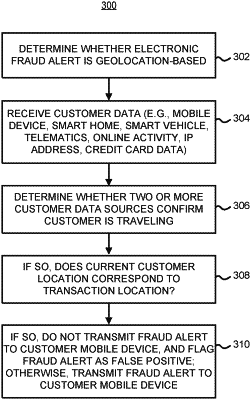| CPC G06Q 20/4016 (2013.01) [G06Q 20/24 (2013.01); G06Q 20/3224 (2013.01); G06Q 20/409 (2013.01)] | 19 Claims |

|
1. A computer-implemented method, implemented in one or more servers, of preventing fraudulent online financial transactions, the method comprising:
receiving, by one or more processors of the one or more servers, a request to authorize a financial transaction, wherein the financial transaction (i) is associated with a debit or credit card account and (ii) is an online transaction purportedly being entered into by an authorized cardholder associated with the debit or credit card account;
receiving, by the one or more processors, an IP address associated with a computing device at which information associated with the debit or credit card account was entered in connection with the financial transaction, and a transaction time associated with the financial transaction;
determining, by the one or more processors and at least in part by using the IP address as a key to a geographic location database, a first geographic location associated with the computing device;
receiving, from a first location data source, first location data associated with the authorized cardholder at a first time;
receiving, from a second location data source different from the first location data source, second location data associated with the authorized cardholder at a second time different from the first time, wherein the first location data source and the second location data source each includes at least one of:
a GPS data source of a mobile device associated with the authorized cardholder;
a vehicle telematics data source of a vehicle associated with the authorized cardholder;
a social media application associated with the authorized cardholder;
a smart appliance associated with the authorized cardholder; or
a WiFi access point;
determining a second geographic location associated with the authorized cardholder, at a time associated with the transaction time, from the first location data and the second location data, wherein determining the second geographic location comprises comparing the transaction time to the first time and the second time;
comparing, by the one or more processors, the second geographic location associated with the authorized cardholder to the first geographic location associated with the computing device; and
in response to determining that the second geographic location does not correspond to the first geographic location, preventing, by the one or more processors, the financial transaction from being executed.
|